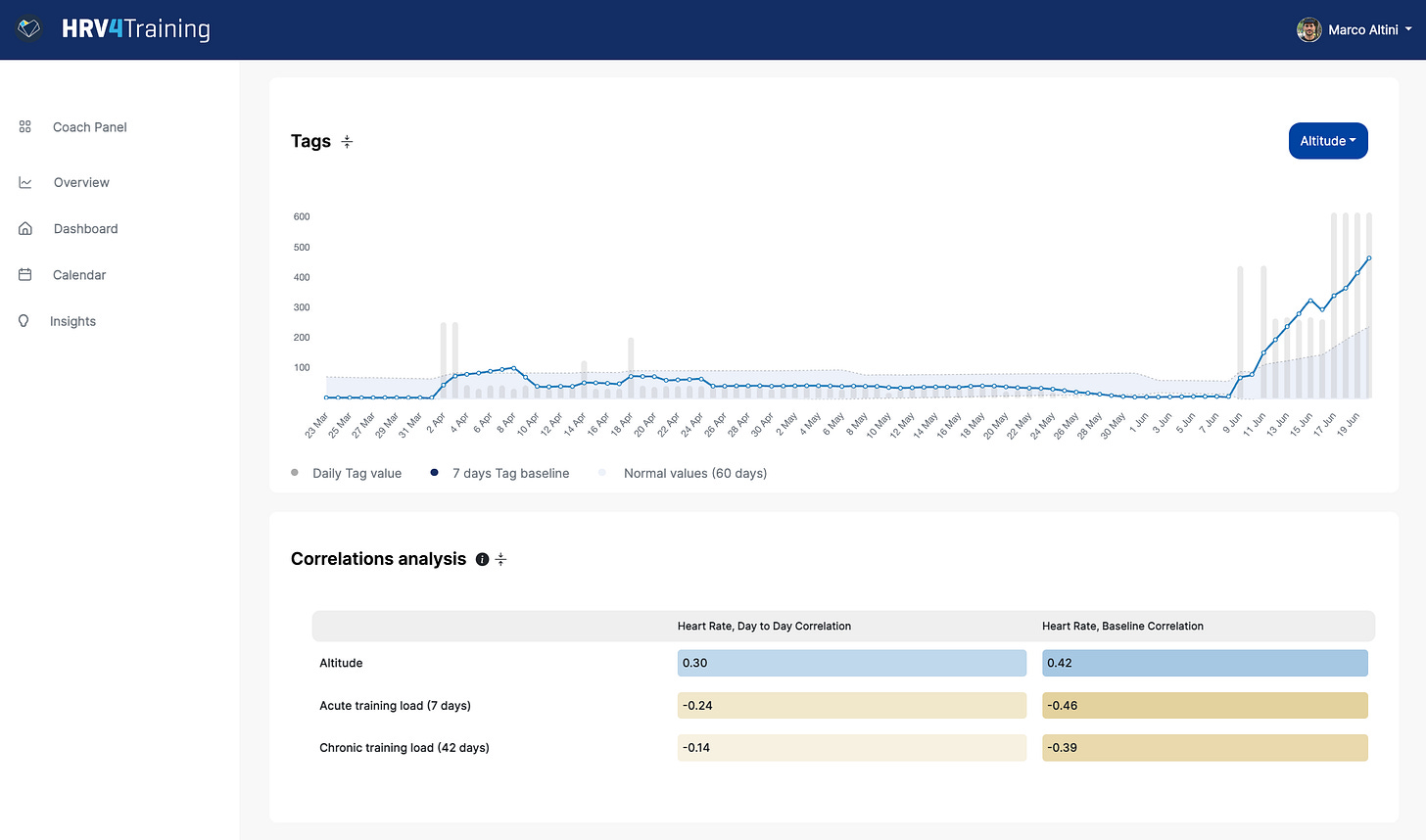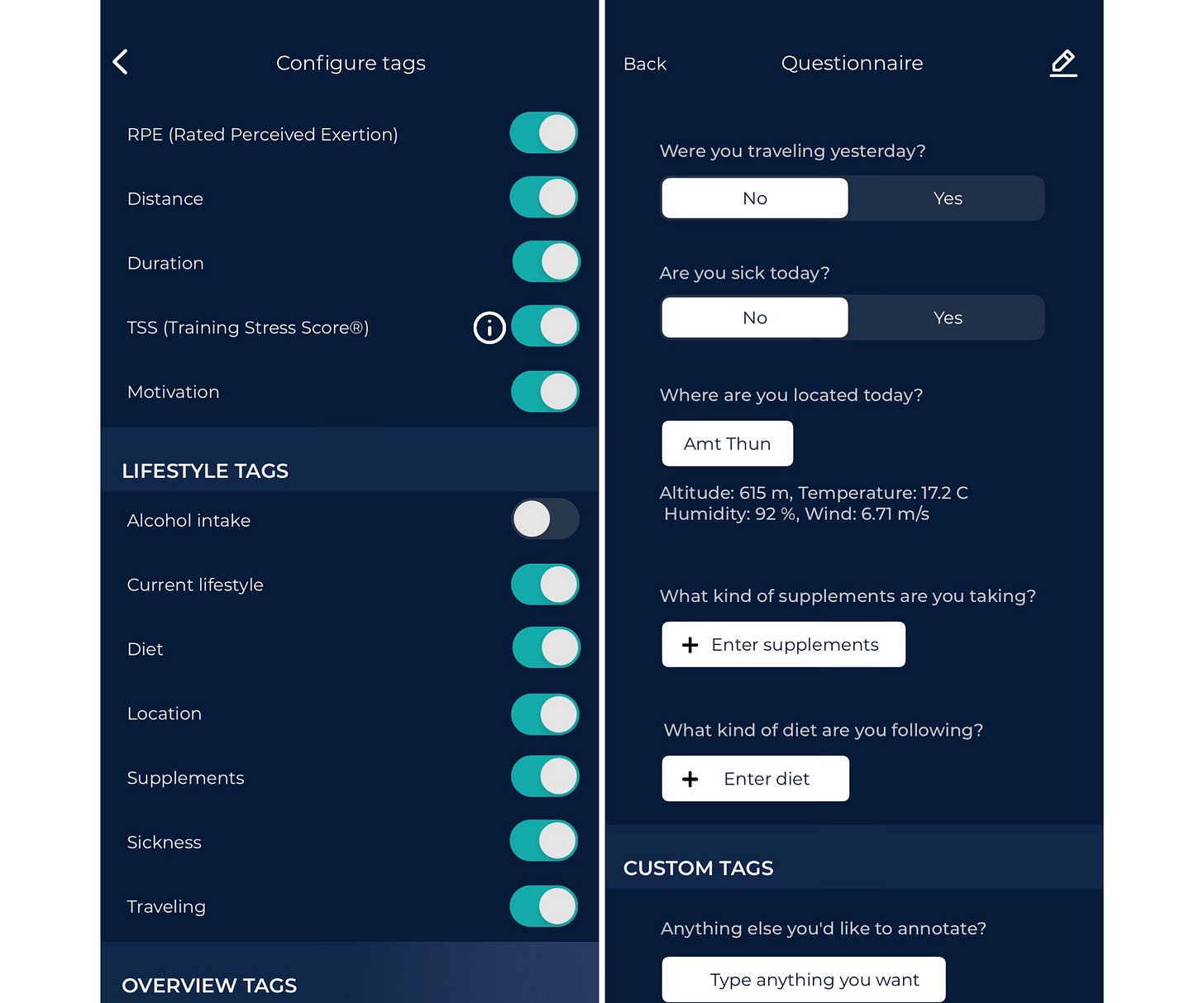
A few years ago I went back to University to study Sports Science (it’s never too late!), and had the opportunity to work with the Dutch Triathlon Federation, looking at some of the data they had collected using HRV4Training during training camps at altitude.
Taking from my thesis [1]: training camps provide a unique opportunity for coaches to manipulate training-related variables (duration and intensity of the sessions for example) in an attempt to trigger specific adaptations that should result in improved performance. Similarly, environmental variables could be manipulated while maintaining training constant, for example during a training camp at altitude or in the heat.
While the rationale behind training at altitude is clear and well documented, with an increase in red blood cells and improved oxygen carrying capacity resulting from spending time in a hypoxic environment, athletes often respond differently and not always positively.
Some athletes might adapt to the novel stimulus and improve, while others might struggle or require more time to adapt. In this context, HRV could provide a simple, non-invasive assessment of the ability of each athlete to deal with the stressors imposed by the training camp (e.g. increased training load, traveling, spending time at altitude, etc.) and could allow the coach to further adjust training plans at the individual level.
In this blog, we’ll look at some of the literature, including my own study, and show how altitude (and weather) can be tracked automatically in HRV4Training, so that you can use that information in various analytics we provide (e.g. as context, in correlation analysis or as filters when looking at aerobic efficiency in HRV4Training Pro).
What does the research say?
This is by no means an exhaustive literature review, but simply an short overview of some of the work that has been done in the field.
Buchheit et al. [2] analyzed HRV responses to acute hypoxia both at rest and during exercise back in 2003. As Buchheit puts it, physiological adaptations are more and more relevant today as not only athletes but more people in general travel and get exposed to different environmental conditions. What the authors reported at simulated altitude (4800m) was a decrease in vagal-related HRV indexes (RMSSD and absolute HF power), suggesting a reduced vagal control of the heart.
Few studies have analyzed HRV at rest and under hypoxia and sometimes with inconsistencies, possibly due simply to individual variability and the differences in subjects populations involved, which are typically limited to a small number of individuals. For example, while a certain reduction in parasympathetic activity has been shown multiple times, Bernardi et al. [3] put through simulated altitude different groups of subjects, from controls to yoga teachers, and showed how in yoga teachers all changes were blunted.
Kanai et al [4] also showed reductions in HRV indices representative of parasympathetic activity at two different simulated elevations (2700 and 3700m). In particular, reductions were greater at higher altitude, showing a progressive reduction in parasympathetic activity with more altitude. Some researchers have proposed that a decrease in HRV indicates a reduction in the autonomic nervous system responsiveness and an inability to adapt the body to challenging conditions.
Liu et al [5] brought more evidence to the reduced rMSSD during hypoxia hypothesis.
In most of these studies, longitudinal data is missing, as the technology we have today was not available, and taking measurements daily was often impractical. However, a very interesting study from Huang et al. [7] followed longitudinally trekkers from seal level and then at altitude, showing how trekkers with acute mountain sickness despite having similar HRV at sea level, had a more pronounced reduction at altitude, which might be a way to identify poor adaptation or individuals at higher risk (more on this later, when covering our study). The authors also showed how a greater reduction at moderate altitude (1317m) was predictive of an even greater reduction at and acute mountain sickness at higher altitude (3440m).
In our study [1], four athletes spent 3 weeks at altitude on two consecutive years. We split the athletes between responders and non-responders based on the ratio between velocity and heart rate during aerobic running workouts (details and rationale here), and found that resting heart rate was significantly more elevated during the beginning of the training camp for non-responders. Similarly, the coefficient of variation of rMSSD also increased by a greater extent for non-responders and the difference in rMSSD was lower during the first week of camp for non-responders. Hence, athletes that responded positively to a three-week training camp at altitude showed a more favorable physiological response during the beginning of the training camp (smaller resting heart rate difference, lower coefficient of variation of rMSSD).
We speculate that this information could be used to further adjust training plans at the individual level.
Most of these studies involve only male subjects and are limited to a handful of participants, limiting our understanding of how altitude affects physiology in different subpopulation and making it hard to understand how we can adapt what we learn from this research and apply it to the individual (e.g. ourselves or the athletes you might be coaching). What do we expect given an athlete characteristics and background? Does a different response mean there’s something we can do? We hope that by collecting more data on a more diverse population we will be able to shed some light in the future.
Altitude and weather tracking in HRV4Training
A little known feature in HRV4Training is the ability to track altitude and weather automatically, and to use this information in a number of analytics and insist.
For example we include altitude and temperature in the Correlation analysis under Insights. The traveling Tag will also be updated automatically when location changes, and all data will be available to your coach in HRV4Training Pro. In particular, the Location tag will enable the following functionalities:
Automatic location tracking (city name).
Altitude data logging.
Weather data logging (temperature and humidity).
Correlation analysis between resting physiological data, altitude, and temperature.
In HRV4Training Pro you can use altitude and weather tracking also in the context of analyzing your aerobic efficiency and cardiac drift.

What do you have to do to enable this feature?
Go to Settings / Configure TAGS and enable the Location tag so that the app will ask for authorization to track your location. At that point, the app will read your location only once, right before the measurement in the morning, and pre-populate your tags. You can still change the location name without affecting altitude and weather data. Make sure to be connected to the internet as weather data is retrieved through third-party APIs and this procedure requires an internet connection.
I hope this was informative, and thank you for reading!
References
[1] Altini, M. “Heart rate variability is representative of individual training adaptation to an altitude training camp in elite triathletes”. Available from: https://www.researchgate.net/publication/342260334_Heart_rate_variability_is_representative_of_individual_training_adaptation_to_an_altitude_training_camp_in_elite_triathletes.
[2] Buchheit, M., et al. "Effect of acute hypoxia on heart rate variability at rest and during exercise." International journal of sports medicine 25.04 (2004): 264-269.
[3] Bernardi, Luciano, et al. "Breathing patterns and cardiovascular autonomic modulation during hypoxia induced by simulated altitude." Journal of hypertension 19.5 (2001): 947-958.
[4] Kanai, Masaki, et al. "Alterations in autonomic nervous control of heart rate among tourists at 2700 and 3700m above sea level." Wilderness & environmental medicine 12.1 (2001): 8-12.
[5] Liu, X. X., et al. "Analysis of heart rate variability during acute exposure to hypoxia." Hang tian yi xue yu yi xue gong cheng= Space medicine & medical engineering 14.5 (2001): 328-331.
[6] Achten, Juul, and Asker E. Jeukendrup. "Heart rate monitoring." Sports medicine 33.7 (2003): 517-538.
[7] Huang, Hsien-Hao, et al. "Alternations of heart rate variability at lower altitude in the predication of trekkers with acute mountain sickness at high altitude." Clinical Journal of Sport Medicine 20.1 (2010): 58-63.
Marco holds a PhD cum laude in applied machine learning, a M.Sc. cum laude in computer science engineering, and a M.Sc. cum laude in human movement sciences and high-performance coaching.
He has published more than 50 papers and patents at the intersection between physiology, health, technology, and human performance.
He is co-founder of HRV4Training, advisor at Oura, guest lecturer at VU Amsterdam, and editor for IEEE Pervasive Computing Magazine. He loves running.
Social:







Fascinating information. I have many clients whom travel from sea-level to altitude for long weekends which often involve being active and often around skiing. As such, the HRV conversation is pertinent and common, so I appreciate the insights.